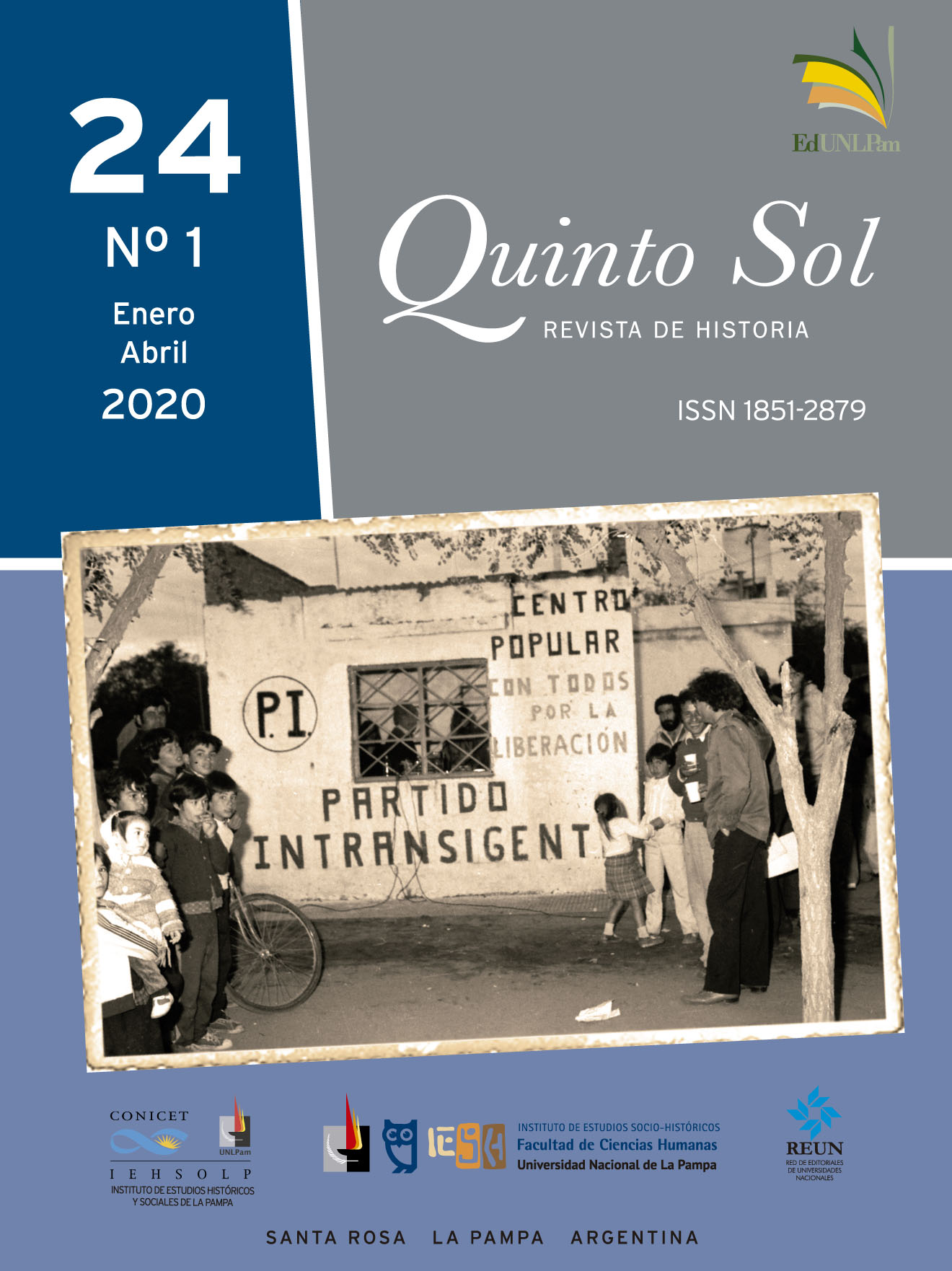Los que seleccionan (y los seleccionados). Una aproximación a los diputados nacionales peronistas por la provincia de Buenos Aires entre 1946 y 1955
DOI:
https://doi.org/10.19137/qs.v24i1.3085Palabras clave:
peronismo, diputados nacionales, elecciones, partidos políticosResumen
El artículo estudia el proceso de selección de candidatos a diputados nacionales por el peronismo en cuatro elecciones sucesivas, desarrolladas en 1946, 1948, 1951 y 1954 en el escenario constituido por la provincia de Buenos Aires. Se analiza, en cada caso, el grupo dirigente que controló el proceso selectivo, las normas formales o informales prevalecientes y los criterios o lógicas que presidieron el proceso. El trabajo se inscribe en líneas actuales de investigación en relación con el primer peronismo, tanto la que subraya el papel de los dirigentes de segunda línea como la que privilegia el estudio de la política provincial. Se aporta al conocimiento empírico del personal político peronista y a la discusión sobre la dimensión organizativa de este movimiento.
Descargas
Citas
Abal Medina, J. y Suárez Cao, J. (2003). Análisis crítico del sistema electoral argentino. Evolución histórica y desempeño efectivo. Revista de Ciencias Sociales, 14, 121-150.
Aelo, O. (Ed.) (2010). Las configuraciones provinciales del peronismo: actores y prácticas políticas, 1945-1955. La Plata, Argentina: Instituto Cultural de la Provincia de Buenos Aires.
Aelo, O. (2012). El peronismo en la provincia de Buenos Aires, 1946-1955. Caseros, Argentina: Universidad Nacional de Tres de Febrero.
Barry, C. (2009). Evita Capitana. El Partido Peronista Femenino, 1949-1955. Caseros, Argentina: Universidad Nacional de Tres de Febrero.
Cámara de Diputados de la Provincia de Buenos Aires. (1946-1955). Diario de Sesiones. La Plata, Argentina: Taller de Impresiones Oficiales.
Registro Oficial de la Provincia de Buenos Aires (1943-1955). La Plata, Argentina: Taller de Impresiones Oficiales.
Senado de la Provincia de Buenos Aires. (1946-1955): Diario de Sesiones. La Plata, Argentina: Taller de Impresiones Oficiales.
Calvo, E. (2013). Representación política, política pública y estabilidad institucional en el Congreso argentino. En C. Acuña (Ed.) ¿Cuánto importan las instituciones? (pp. 121-155). Buenos Aires, Argentina: Siglo XXI.
Cantón, D. (1966). El Parlamento argentino en épocas de cambio: 1890, 1916 y 1946. Buenos Aires, Argentina: Editorial del Instituto.
Cursack, R. (1947). Ideario social y político del Partido Único de la Revolución Nacional. Su organización en la Provincia de Buenos Aires. Buenos Aires, Argentina: s/e.
Diccionario biográfico de la provincia de Buenos Aires. (1954). Buenos Aires, Argentina: "C" Siglo Editorial Argentino.
Di Tella, T. (2003). Perón y los sindicatos. Buenos Aires, Argentina: Ariel.
Doyon, L. (2006). Perón y los trabajadores. Los orígenes del sindicalismo peronista, 1943-1955. Buenos Aires, Argentina: Siglo XXI.
Ferrari, M. (2010). Prosopografía e historia política. Algunas aproximaciones. Antíteses, 3 (5), 529-550.
Gay, L. (1999). El Partido Laborista en la Argentina. Buenos Aires, Argentina: Biblos.
Joignant, A. (2012). Habitus, campo y capital. Elementos para una teoría general del capital político. Revista Mexicana de Sociología, 74 (4), 587-618. Permalink: http://ref.scielo.org/t7xffz
Luna, F. (1972). El 45. Buenos Aires, Argentina: Sudamericana.
Mackinnon, M. (2002). Los años formativos del Partido Peronista. Buenos Aires, Argentina: Siglo XXI-Instituto Torcuato Di Tella.
Macor, D. y Tcach, C. (Eds.) (2013). La invención del peronismo en el interior del país, II. Santa Fe, Argentina: Universidad Nacional del Litoral.
Monzalvo, L. (1974). Testigo de la primera hora del peronismo. Buenos Aires, Argentina: Pleamar.
Morgensten, S. y Nacif, B. (Eds.) (2002). Legislative Politics in Latin America. Cambridge, Reino Unido: Cambridge University Press.
Mustapic, A. (Ed.) (2012). Los legisladores en el Congreso argentino. Buenos Aires, Argentina: Instituto Torcuato Di Tella.
Norris, P. (Ed.) (1997). Passages to power. Legislative recruitment in advanced democracies. Cambridge, Reino Unido: Cambridge University Press.
Privitellio, L. (2011). Las elecciones entre dos reformas: 1900-1955. En H. Sábato, M. Ternavasio, L. Privitellio y A. Persello. Historia de las elecciones en la Argentina: 1805-2011 (pp. 135-233). Buenos Aires, Argentina: El Ateneo.
Quién es quién en la Argentina. Biografías contemporáneas. (1947, 1950. 1958-1959). Buenos Aires, Argentina: Guillermo Kraft.
Rahat, G. (2007). Candidate Selection: the Choice before the Choice. Journal of Democracy, 18, (1), 157-170. DOI: https://doi.org/10.1353/jod.2007.0014
Reyes, C. (1984). Yo hice el 17 de Octubre. Memorias. Buenos Aires, Argentina: Centro Editor de América Latina.
Rodrigo, C. (2014). Actores, relaciones y escaños. Apuntes para el estudio de las carreras políticas de los diputados nacionales por la Provincia de Buenos Aires. Estudios, 32, 135-148. DOI: https://doi.org/10.31050/1852.1568.n32.11587
Senén González, S. (2014). Laborismo. El partido de los trabajadores. Buenos Aires, Argentina: Capital intelectual.
Valobra, A. (2010). Del hogar a las urnas. Recorridos de la ciudadanía política femenina. Argentina, 1946-1955. Rosario, Argentina: Prohistoria.
Publicado
Número
Sección
Licencia
Al momento de enviar sus contribuciones, los colaboradores deberán declarar que poseen el permiso del archivo o repositorio donde se obtuvieron los documentos que se anexan al trabajo, cualquiera sea su formato (manuscritos inéditos, imágenes, archivos audiovisuales, etc.), permiso que los autoriza a publicarlos y reproducirlos, liberando a la revista y sus editores de toda responsabilidad o reclamo de terceros.
Asimismo, los autores deben adherir a la licencia Creative Commons denominada “Atribución - No Comercial CC BY-NC-SA”, mediante la cual el autor permite copiar, reproducir, distribuir, comunicar públicamente la obra y generar obras derivadas, siempre y cuando se cite y reconozca al autor original. No se permite, sin embargo, utilizar la obra con fines comerciales. Los autores podrán establecer acuerdos adicionales para la distribución no exclusiva de la versión de la obra publicada en la revista (por ejemplo, situarlo en un repositorio institucional o publicarlo en un libro), con el reconocimiento de haber sido publicado primero en esta revista.
La publicación de contenidos en esta revista no implica regalía ni cargo alguno para los/as contribuyentes.
Quinto Sol adhiere adhiere a DORA (Declaration on Research Assessment) firmada en San Francisco, California, el 16 de diciembre de 2012, y a la Declaración de México (Declaración Conjunta LATINDEX - REDALYC - CLACSO - IBICT).











4.png)
2.png)











_(2).png)


.jpg)



1.jpg)
9.png)



